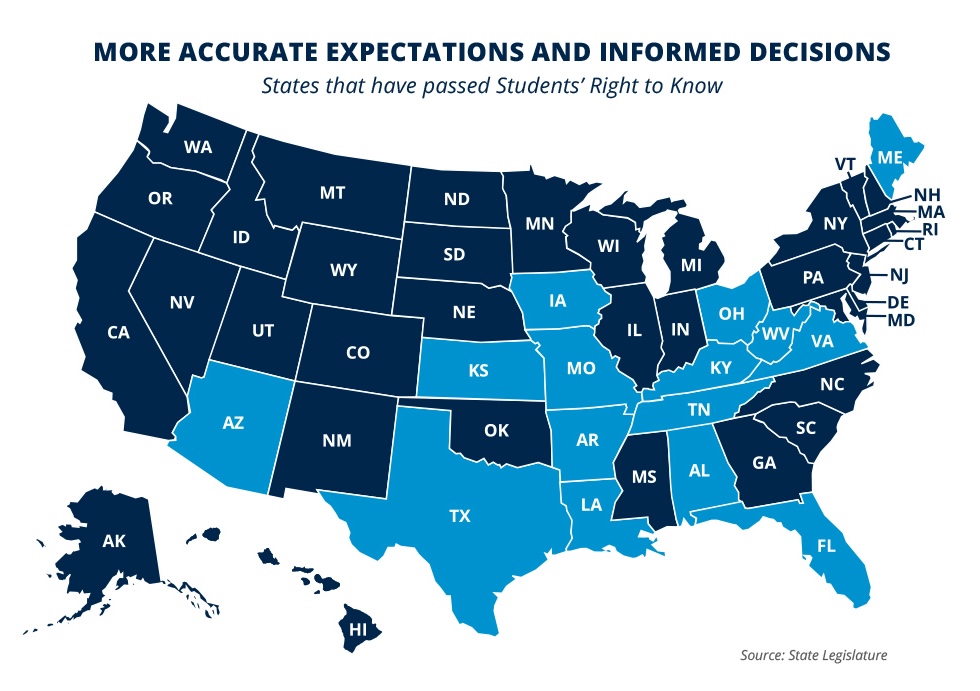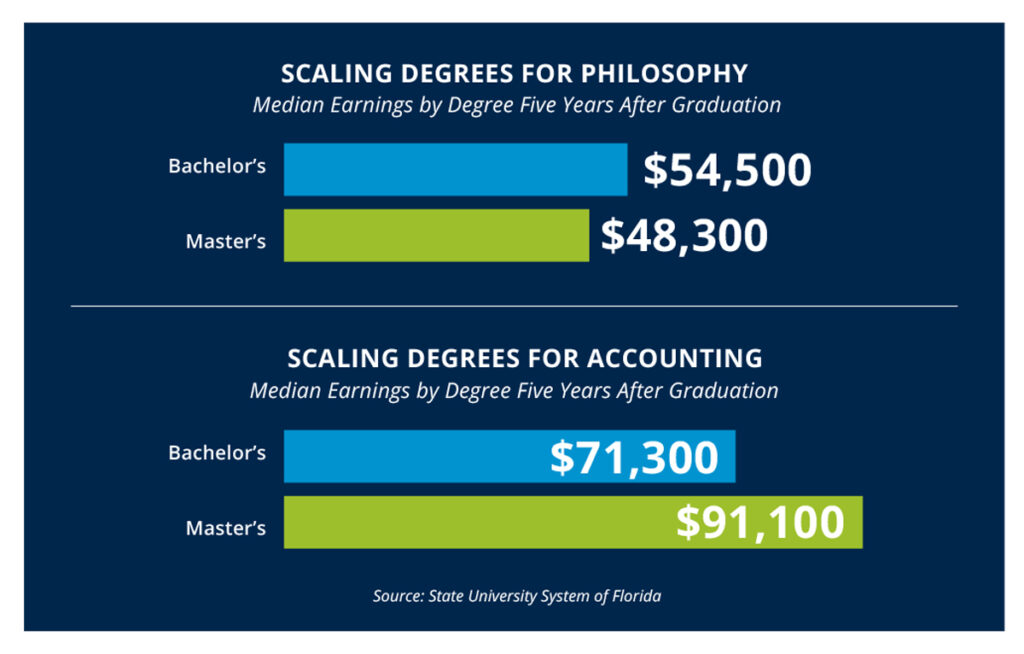Students’ Right to Know: How States Across the Country Have Empowered Students to Choose Successful Pathways
KEY FINDINGS
- Going to college can help lead to higher earnings but it does not guarantee success.
- Student loan debt now exceeds $1.76 trillion.
- Students’ Right to Know laws provide high school students with access to information about college, like average cost, average loan amounts, graduation rates, and employment prospects.
- 15 states have implemented a version of Students’ Right to Know.
- Florida has led the way with a public dashboard that makes it easy for students to compare different paths.
Background
College tuition costs have soared in recent years, and student debt is on the rise as well. In the last 30 years, public college tuition costs have risen from $4,870 to $10,940 annually, adjusted for inflation.1 Americans currently hold $1.76 trillion in unpaid student debt, and more than half of college students leave school with student loan debt.2-3 While earning a degree can lead to higher wages, 35 percent of student debt holders never complete a college degree.4

In general, higher levels of education can lead to higher lifetime earnings, but attending college does not guarantee success.5 As of June 2023, 40 percent of recent college graduates were underemployed, meaning that they were working in jobs that do not typically require a degree.6 Variables like the institution and field of study have a big impact on future job opportunities. More than half of college graduates with a liberal arts degree were underemployed, while the rate of underemployment for graduates of nursing programs was only 10 percent.7 The level of education required to realize higher earnings also differs based on the field of study. For instance, workers with associate’s degrees in computer- or math-related fields have the same lifetime earnings compared to the average bachelor’s degree holder.8
Most new jobs being created today do not require a college degree at all. The Bureau of Labor Statistics estimates that 60 percent of new jobs added to the economy between 2020 and 2030 will be in occupations that do not require a college education.9 Many of these jobs, such as those in the construction and transportation industry, have higher earnings than the median annual salary for all occupations.10 Just 20 percent of new jobs being created require a bachelor’s degree.11
Students’ expectations about college are not aligned with reality
Students have unrealistic expectations about both graduating from college and future employment prospects. While 90 percent of incoming college students expect to finish a bachelor’s degree in four years, less than half actually achieve this.12 Only 62 percent of students graduate with a bachelor’s degree after six years, and only 43 percent of students who start an associate’s degree graduated within six years.13


Current college students expect to earn twice what the average college graduate actually earns.14 Simply put, high school students need to be better informed about graduation and employment prospects of particular schools and fields of study before they decide what their plans will be after high school.
15 states have passed Students’ Right to Know
States across the country have helped students have more accurate expectations and make informed decisions. Students’ Right to Know laws require information to be provided to prospective students, such as how many students in each degree program have full-time employment or are enrolled in post-graduate education, average wages for graduates of each degree program at different levels of education, and average student debt.15
By 2022, 10 states had passed Students’ Right to Know legislation.16 More recently, Students’ Right to Know bills have also been signed into law in Alabama, Iowa, Ohio, Texas, and Virginia, bringing the total to 15 states.17-21

For example, Texas requires the Texas Education Agency to post information on the costs and potential benefits of obtaining a degree or certificate at Texas institutions including the total cost of attendance, the graduation rate, the percentage of graduates employed in a related field, and the median earnings of graduates in dollars and as a percentage of average student debt.22 Texas also requires students to be provided with information on what career fields are projected to be most in demand in the state in the future.23
Arizona requires public institutions to distribute information directly to high schools as well as making it publicly available. The information required to be disclosed includes the cost of attendance, in-demand career fields with their starting salary and level of education required, graduation rates and average wages for associate’s and bachelor’s degrees, and completion rates and average wages for apprenticeships and career and technical education.24
It is vital that incoming college students have accurate information about career and employment outcomes of degree programs before they start. Survey data show that 61 percent of college graduates would change their major if they could.25 Of those who would change their chosen major, more than 60 percent cited the reason as being related to wanting better pay and benefits or different career opportunities.26
States that have passed Students’ Right to Know have given high schoolers this information up front, empowering them to make the right decision the first time. Some states have prioritized not only providing information to students, but also making it easy to compare different choices.

Florida has led the way with a public dashboard that allows students to compare pathways
Florida has gone beyond simply requiring colleges to publish information by implementing a dashboard that displays outcomes by university, degree program, and level of education.27 This public dashboard makes it easy for students to compare different fields of study and levels of education.28
For example, the dashboard shows that the median earnings of a worker with a bachelor’s degree in philosophy are more than $6,000 higher than the earnings of those with a master’s degree in philosophy.29 Meanwhile, median earnings for someone with a master’s degree in accounting are $20,000 higher than those with a bachelor’s degree.30 This information helps students determine if continuing their education will pay off.

Florida’s dashboard also includes information about associate degree programs and professional certificates, allowing students to compare and consider the full range of options after high school.31
Having information up front helps students decide which field of study to choose, which institution to attend, and what level of degree to complete.
The Bottom Line: Many states across the country have passed Students’ Right to Know and have equipped students with the information they need to make good decisions about their futures.
For some students, a college degree is the right choice. But it is not always the pathway to bigger salaries and better job opportunities. Many high-paying jobs do not require a bachelor’s degree and some fields of study are more valuable than others. Some fields require masters- or doctorate-level education to realize higher earnings, but in other fields of study the opposite is true.
The costs of college continue to rise, and so does the percentage of adults who carry student loan debt. States that have passed Students’ Right to Know have taken an important step towards solving this problem. When students have information about graduation rates, earnings, and employment up front, they can make informed decisions about their future and better set themselves up for success.
References
1 Jennifer Ma et al., “Trends in college pricing and student aid 2022,” The College Board (2022), https://research.collegeboard.org/media/pdf/trends-in-college-pricing-student-aid-2022.pdf.
2 The Board of Governors of the Federal Reserve System, “Consumer credit-G.19,” The Federal Reserve (2023), https://www.federalreserve.gov/releases/g19/current/default.htm.
3 Jennifer Ma et al., “Trends in college pricing and student aid 2022,” The College Board (2022), https://research.collegeboard.org/media/pdf/trends-in-college-pricing-student-aid-2022.pdf.
4 Neil Bhutta et al., “Changes in U.S. family finances from 2016 to 2019: Evidence from the survey of consumer finances,” The Federal Reserve (2020), https://www.federalreserve.gov/econres/scfindex.htm.
5 Anthony P. Carnevale et al., “The college payoff: More education doesn’t always mean more earnings,” Georgetown University Center on Education and the Workforce (2021), https://cew.georgetown.edu/cew-reports/collegepayoff2021/.
6 Federal Reserve Bank of New York, “The labor market for recent college graduates,” The Federal Reserve (2023), https://www.newyorkfed.org/research/college-labor-market/index.html.
7 Ibid.
8 Anthony P. Carnevale et al, “The college payoff: More education doesn’t always mean more earnings,” Georgetown University Center on Education and the Workforce (2021) https://cew.georgetown.edu/cew-reports/collegepayoff2021/.
9 Ryan Farrell et al., “Fast-growing occupations that pay well and don’t require a college degree,” The Bureau of Labor Statistics (2022), https://www.bls.gov/careeroutlook/2022/article/occupations-that-dont-require-a-degree.htm.
10 Ibid.
11 Jonathan Ingram, “House-proposed work requirements would limit dependency, save taxpayer resources, and grow the economy,” Foundation for Government Accountability (2023), https://thefga.org/research/house-proposed-work-requirements/.
12 Trevor Carlson, “Prospective students deserve real facts up front from colleges and universities,” Foundation for Government Accountability (2022), https://thefga.org/research/students-deserve-facts-up-front/.
13 Jon Marcus, “Most college students don’t graduate in four years, so college and the government count six years as ‘success’,” The Hechinger Report (2021), https://hechingerreport.org/how-the-college-lobby-got-the-government-to.measure-graduation-rates-over-six-years-instead-of-four/.
14 Trevor Carlson, “Prospective students deserve real facts up front from colleges and universities,” Foundation for Government Accountability (2022), https://thefga.org/research/students-deserve-facts-up-front/.
15 Foundation for Government Accountability, “Students’ right to know,” Foundation for Government Accountability (2022), https://thefga.org/one-pagers/studentsrighttoknow/.
16 Ibid.
17 Alabama State Legislature, “SB176,” State of Alabama (2023), https://www.legislature.state.al.us/pdf/SearchableInstruments/2023RS/SB176-enr.pdf.
18 Iowa General Assembly, “House file 135,” State of Iowa (2023), https://www.legis.iowa.gov/legislation/BillBook?ga=90&ba=HF135.
19 Ohio General Assembly, “Substitute senate bill number 35,” State of Ohio (2022), https://search-prod.lis.state.oh.us/solarapi/v1/general_assembly_134/bills/sb135/EN/05/sb135_05_EN?format=pdf.
20 Texas State Legislature, “House bill No. 2920,” State of Texas (2023), https://capitol.texas.gov/tlodocs/88R/billtext/html/HB02920I.htm.
21 Virginia General Assembly, “Virginia acts of assembly 2022,” Commonwealth of Virginia (2022), https://lis.virginia.gov/cgi-bin/legp604.exe?221+ful+CHAP0343+pdf.
22 Texas State Legislature, “House Bill No. 2920,” State of Texas (2023), https://capitol.texas.gov/tlodocs/88R/billtext/html/HB02920I.htm.
23 Ibid.
24 ARS § 41-1509, https://www.azleg.gov/ars/41/01509.htm.
25 Reece Johnson, “New survey finds most college grads would change major,” Best Colleges (2023), https://www.bestcolleges.com/blog/college-graduate-majors-survey/.
26 Ibid.
27 Hayden Dublois, “How the sunshine state has used transparency and innovation to open up new workforce pathways,” Foundation for Government Accountability (2023), https://thefga.org/research/sunshine-state-open-up-new-workforce-pathways/.
28 Board of Governors, “MyFloridaFuture tool,” State University System of Florida (2022), https://www.flbog.edu/myfloridafuture/my-florida-future-dashboard.
29 Ibid.
30 Ibid.
31 Ibid.
